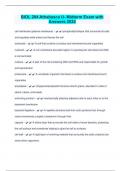Chromoplast - Study guides, Class notes & Summaries
Looking for the best study guides, study notes and summaries about Chromoplast? On this page you'll find 31 study documents about Chromoplast.
All 31 results
Sort by
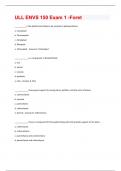
-
ULL ENVS 150 Exam 1 -Foret Updated 2024/2025 with complete solutions
- Exam (elaborations) • 24 pages • 2024
- Available in package deal
-
- $7.99
- + learn more
__________ is the plastid most likely to be involved in photosynthesis. a. Leucoplast b. Chromoplast c. Amyloplast d. Riboplast e. Chloroplast - Answer-E. Chloroplast ____________ is a crop grown in flooded fields. a. rice b. wheat c. cassava d. potatoes e. oats - Answer-A. Rice ____________ tissue gives support to young stems, petioles, and the veins of leaves. a. sclerenchyma b. vascular c. parenchyma d. collenchyma e. dermal - Answer-D. Collenchyma ____________ tissue is com...
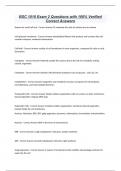
-
BSC 1010 Exam 2 Questions with 100% Verified Correct Answers
- Exam (elaborations) • 8 pages • 2024
- Available in package deal
-
- $10.99
- + learn more
BSC 1010 Exam 2 Questions with 100% Verified Correct Answers Reason for small cell size - Correct Answer To maximize the ratio of surface area to volume cell (plasma) membrane - Correct Answer phospholipid bilayer that protects and encloses the cell; controls transport; maintains homeostasis Cell Wall - Correct Answer outside of cell membrane in some organisms, composed of carbs or carb derivatives Cytoplasm - Correct Answer Material outside the nucleus that is the site for metabolic a...
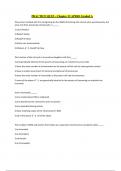
-
PRACTICE QUIZ - Chapter 12 APBIO Graded A
- Exam (elaborations) • 11 pages • 2024
-
Available in package deal
-
- $9.99
- + learn more
PRACTICE QUIZ - Chapter 12 APBIO Graded A The person credited with first recognizing (in the 1860s) that living cells cannot arise spontaneously, but arise only from previously existing cells, is _____. 1) Louis Pasteur 2) Robert Hooke 3) Rudolf Virchow 4) Anton van Leeuwenhoek 5) Watson ️3. Rudolf Virchow The function of the cell cycle is to produce daughter cells that _____. 1) are genetically identical to the parent cell (assuming no mutation has occurred) 2) have the sa...
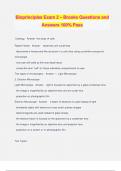
-
Bioprinciples Exam 2 – Brooks Questions and Answers 100% Pass
- Exam (elaborations) • 42 pages • 2024
- Available in package deal
-
- $13.49
- + learn more
Bioprinciples Exam 2 – Brooks Questions and Answers 100% Pass Cytology - Answer- the study of cells Robert Hooke - Answer- - observed cork could float - discovered a honeycomb-like structure in a cork slice using a primitive compound microscope - only saw cell walls as this was dead tissue - coined the term "cell" for these individual compartments he saw Two types of microscopes: - Answer- 1. Light Microscope 2. Electron Microscope Light Microscope - Answer- - light is focused on s...

-
Brooks Biological Principles Exam 2 Questions and Correct Answers, Solution Guide 2024 Complete.
- Exam (elaborations) • 15 pages • 2024
-
- $9.49
- + learn more
Brooks Biological Principles Exam 2 Questions and Correct Answers, Solution Guide 2024 Complete. Cytology the study of cells Cell Theory all living things are composed of cells and come from living cells Robert Hooke one of the first to use microscope, observing a piece of cork from the stem of plants, where he found chambers arising in the idea of a cell. Light Microscope takes pictures of large atoms. nucleus, not electrons Scanning Electron Microscope electrons are reflected off ...
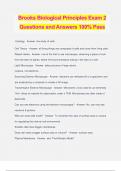
-
Brooks Biological Principles Exam 2 Questions and Answers 100% Pass
- Exam (elaborations) • 25 pages • 2024
-
- $12.49
- + learn more
Brooks Biological Principles Exam 2 Questions and Answers 100% Pass Cytology - Answer- the study of cells Cell Theory - Answer- all living things are composed of cells and come from living cells Robert Hooke - Answer- one of the first to use microscope, observing a piece of cork from the stem of plants, where he found chambers arising in the idea of a cell. Light Microscope - Answer- takes pictures of large atoms. nucleus, not electrons Scanning Electron Microscope - Answer- electrons ar...
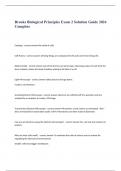
-
Brooks Biological Principles Exam 2 Solution Guide 2024 Complete
- Exam (elaborations) • 26 pages • 2024
- Available in package deal
-
- $11.99
- + learn more
Cytology - correct answer-the study of cells Cell Theory - correct answer-all living things are composed of cells and come from living cells Robert Hooke - correct answer-one of the first to use microscope, observing a piece of cork from the stem of plants, where he found chambers arising in the idea of a cell. Light Microscope - correct answer-takes pictures of large atoms. nucleus, not electrons Scanning Electron Microscope - correct answer-electrons are reflected off of a specime...
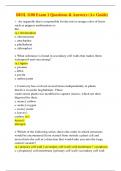
-
BIOL 1108 Exam 1 Questions & Answers (A+ Guide)
- Exam (elaborations) • 13 pages • 2023
-
Available in package deal
-
- $14.03
- + learn more
BIOL 1108 Exam 1 Questions & Answers (A+ Guide)-1. An organelle that is responsible for the red or orange color of fruits such as peppers and tomatoes is the . (a.) chromoplast b. chromosome c. amyloplast d. phelloderm e. chloroplast 2. What substance is found in secondary cell walls that makes them waterproof and very strong? (a.) lignin b. protein c. DNA d. pectin e. anthocyanin 3. Carnivory has evolved several times independently in plants that live in acidic bog habitats. T...
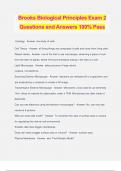
-
Brooks Biological Principles Exam 2 Questions and Answers 100% Pass
- Exam (elaborations) • 25 pages • 2024
-
- $12.49
- + learn more
Brooks Biological Principles Exam 2 Questions and Answers 100% Pass Cytology - Answer- the study of cells Cell Theory - Answer- all living things are composed of cells and come from living cells Robert Hooke - Answer- one of the first to use microscope, observing a piece of cork from the stem of plants, where he found chambers arising in the idea of a cell. Light Microscope - Answer- takes pictures of large atoms. nucleus, not electrons Scanning Electron Microscope - Answer- electrons ar...

How did he do that? By selling his study resources on Stuvia. Try it yourself! Discover all about earning on Stuvia

